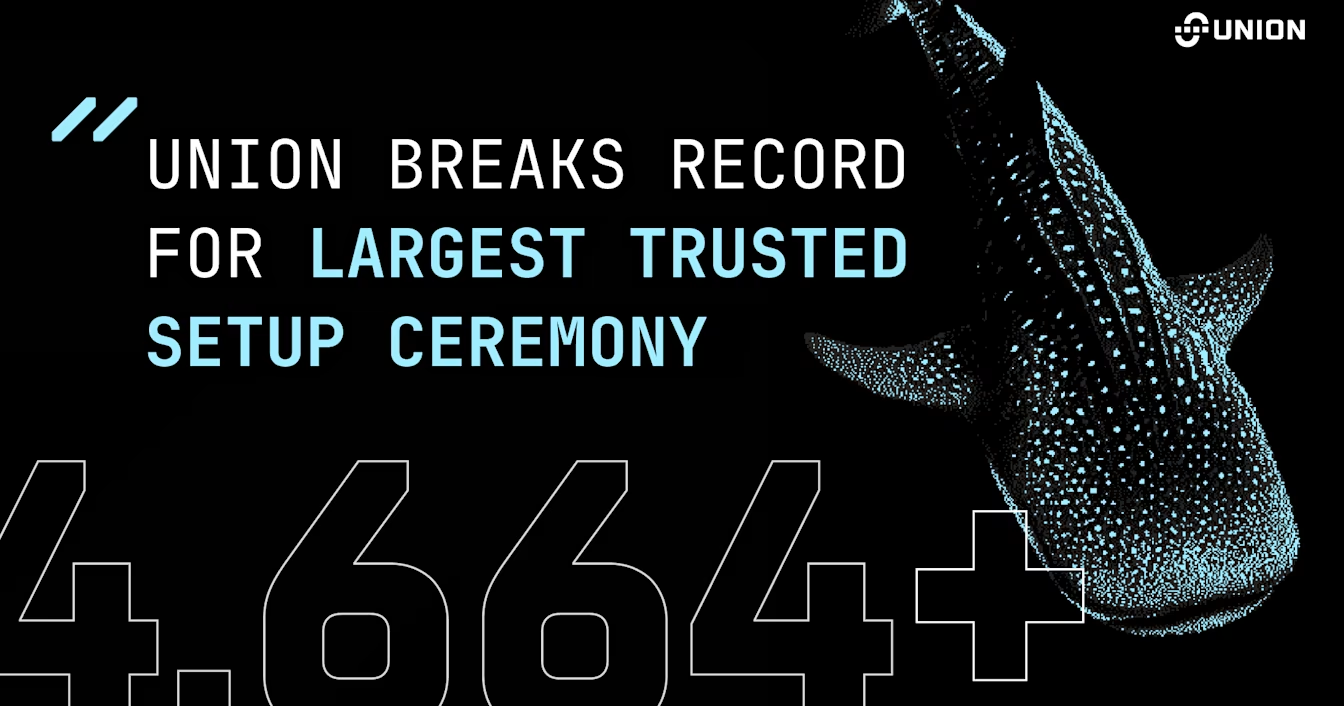June 9th, 2025, Dover, DE - It’s official: 4,664 people have contributed to Union’s Trusted Setup Ceremony, which makes it the largest Groth16 trusted setup ceremony to date. This exceeds the 4,328 contributions of the previous record-breaking ceremony, performed by Manta Network in 2023.
This number is set to grow. Though the queue is closed, those already in the queue are still able to contribute, which will add hundreds of contributions before the ceremony fully closes.
Union’s Trusted Setup Ceremony is the cryptographic backbone of its zero-knowledge interoperability layer, enabling secure, trustless communication across ecosystems like Ethereum, Cosmos, Arbitrum, Babylon, and Berachain. By generating public parameters for its Groth16 ZK proving system, the ceremony ensures that cross-chain actions—like asset transfers and message passing—remain verifiable and efficient.
With 4,664 participants from all over the world, it’s the most decentralized Groth16 ceremony in blockchain history—and the second most decentralized ceremony of any kind, after Ethereum’s KZG ceremony—enhancing security and reducing reliance on centralized actors.
This massive turnout reflects Union’s commitment to decentralization and trustless infrastructure. The resulting parameters power scalable, low-cost interoperability for DeFi, NFTs, and beyond, making Union a cross-chain settlement layer for developers building across chains.
Cor Pruijs, CTO of Union Labs had this to say:
Union's circuit having the largest Groth16 trusted setup ceremony ever means that it has the smallest honesty assumption of all.
This was achieved by making the user experience extremely streamlined. TSCs are complicated cryptographic sequential pipelines, but through clever packaging and a very cool web app, even people with low technical skills were able to participate.
Participation was entirely automated. Contributors’ computers waited until they were told by the coordinator server that it was their turn to start generating. Their output was then automatically verified, added to the sequence, and forwarded to the next participant.
How is Union’s Trusted Setup Ceremony Different from Ethereum’s KZG Ceremony?
Union's Trusted Setup Ceremony and Ethereum’s KZG Ceremony are both multi-party computation processes, but they differ in purpose, scope, and technical focus. Union’s ceremony generates Groth16 parameters to support its zero-knowledge-powered interoperability layer, enabling trustless cross-chain communication across every ecosystem. It’s designed specifically for verifying chain consensus and facilitating secure message passing using ZK proofs and CometBLS.
In contrast, Ethereum’s KZG Ceremony produces a structured reference string (SRS) for KZG commitments, which are vital for scaling solutions like Proto-Danksharding (EIP-4844) and full Danksharding, enabling cheaper and more efficient rollup data availability. The computational requirements to contribute to the KZG ceremony were much lower, resulting in a higher contribution count.
Union’s Next Major Milestone: Mainnet launch
With its trusted setup ceremony now complete, Union is setting its sights on the next major milestone: public mainnet. In April, the core team quietly rolled out a limited beta version powered by PoA consensus to support Babylon Genesis’ launch. Since then, Union has secured 98% of all bridge volume into the Babylon and BTCfi ecosystems by establishing strong ties with leading Bitcoin LST issuers.
The full mainnet launch and token generation event (TGE) are slated for this summer, with more details to follow.
About Union
Dubbed as the “blockchain of blockchains,” Union uses advanced zero-knowledge cryptography to enable lightning-fast and trustless interop across any execution environment. By validating the entire chain consensus in zero-knowledge, Union achieves unprecedented speed and security without relying on external validators, multi-signatures, or oracles. Audited by top security firms and supported by a global network of contributors, Union is the backbone of seamless cross-chain DeFi.
